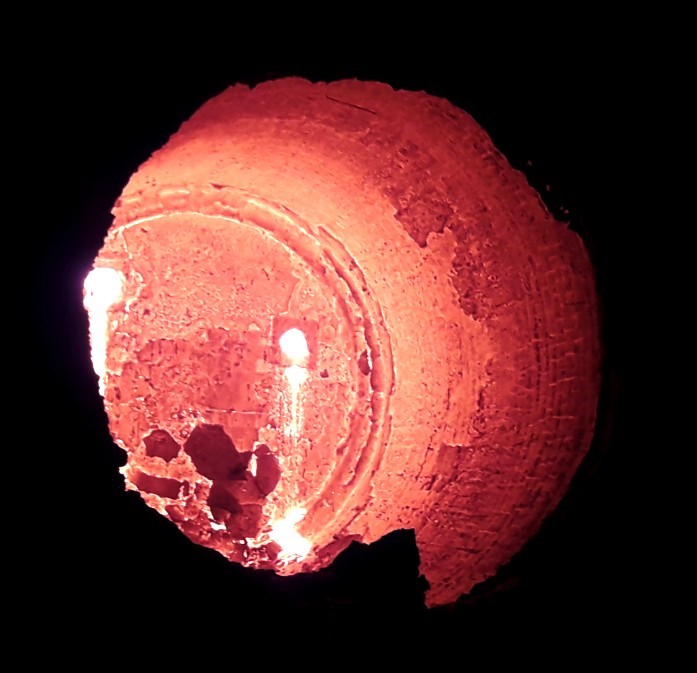Ladle working lining should remain inert to the steel apart from providing wear and corrosion resistance and penetration from slag.
Thermal
Peak Temperature: Being in direct contact with steel, the temperature of the lining rises to that of the steel. In ladle metallurgy arc heating can increase the temperature of the slag even more as the electrodes superheat the slag in order to transfer the heat to the steel bath. The temperature can exceed 1700 deg C. High temperature resistant materials are to be used (MgO-C and dolomite C are to be used).
Thermal Shock: The thermal cycling for the working lining is considerably highand it experiences shock during the tapping of every heat. Thus it ultimately depends on the number of heats per day (Although the number of heats per day varies from 4 to more than 6 in certain shops).
Mechanical
Impact: The impact from the steel is less. The top of the slag line can suffer from impact during the ladle lip skull removal.
Abrasion:The abrasion of the barrel area is dependent on the operation practices. The bath movement being the critical factor for the wear of the refractory. The bath movement is mostly dominated by the purging through the bottom porous plug which is responsible for the wear of the bottom whereas vigorous purging brings turbulence in the bath level which wears the lining.
Applied stress:The height of lining depends on the capacity of the ladle and it varies from shop to shop. The height is responsible for the vertical stress on the lining. Especially when monolithic material, expansion tolerance is to be provided or flexible material is to be used. Flexible material or expansion allowance is to be provided for Alumina-magnesia-carbon brick (AMC) or dolomite bricks owing to their high expansion rate.
Chemical
Dissolution:Wear by dissolution depends on the chemical compatibility of the slags with bricks. Due to the basic nature of the slag basic material are compatible. High Alumina or alumina spinel is the preferred choice (CaF2-fluorspar is used to form liquid slag but its use should be avoided because of its highly corrosive nature.
Penetration:Penetration is caused by low viscosity metal/ slag or highly wetting metal/slag penetrating into porous refractories. which can be a problem for the slagline area. This is a problem for non carbon containing brick where penetration can be even deeper and therefore carbon containing bricks are preferred.
Thermo- Mechanical
Strain of thermal expansion– The height of lining depends on the capacity of the ladle and it varies from shop to shop. The height is responsible for the vertical stress on the lining. Especially when monolithic material, expansion tolerance is to be provided or flexible material is to be used. Flexible material or expansion allowance is to be provided for magnesia-carbon or dolomite brick (MgO-C) or dolomite bricks owing to their high expansion rate.
Chemical Mechanical and thermo mechanical chemical
Spalling of the penetrated zones-This is one of the key wear mechanism. The cumulative effect of high temperatures from slag heating, aggressive slag corrosion, thermal cycling and applied stress on expansion is responsible for ladle slag line wear.
Choice of material
The current practice is the use of bricks of 150-200 mm thickness of either dolomite carbon or magnesia carbon(MgO-C). Carbon percentage is kept high to impart slag resistance properties(10-20%C). It consists of more than 50% fused MgO grains of the highest quality (98-99% purity and medium crystal size greater than 500 micrometers).graphite will also be of the highest purity (98-99%) with a large flake size. Antioxidants (like Al or Al-Mg alloy or Si) are used to protect the carbon and prevent oxidation.
Note: High wear throughout in a band indicates the presence of aggressive slag, heavy wear around the joints indicates an issue with the lip ring integrity and bricks not being in compression whereas the presence of a single distinct hole indicates poor brick or electrode flare or control.
Methods to prevent ladle breakouts from the slagline area
· Controlling the process and matching the brick quality to prevent aggressive slag attacks.
· Lowering thermal cycling to prevent opening up of joints to keep the temperature drop as low as possible.
· Preventing ladle over filling. Controlling the charge weight and tapping.
· Better brick quality is to be ensured.
· Safety lining brick quality plays a role in preventing steel penetration. Monolithic safety lining can act as a barrier in stopping/freezing steel/slag.
· Minimum thickness of the safety lining is to be ensured. Correct repair methodology is to be implemented.
· Inspection to keep lining warpage to a designed level.
· Better and regular visual inspection through laser and thermographic study by trained and experienced operators helps in prevention of breakouts



